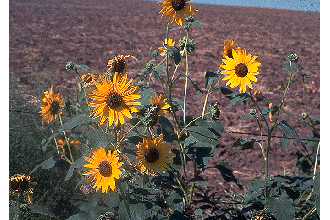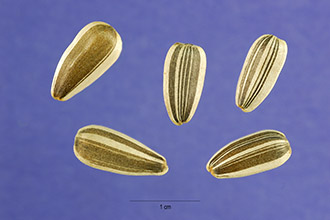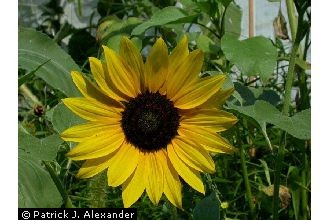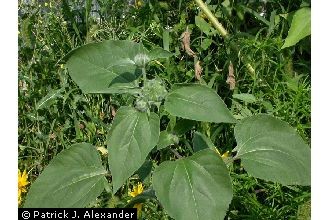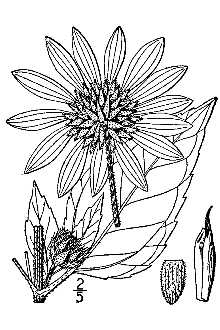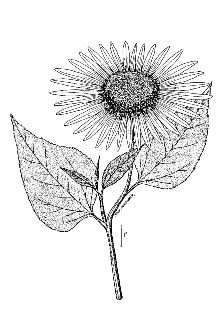Helianthus aridus Rydb.
Scientific Name: Helianthus aridus Rydb.
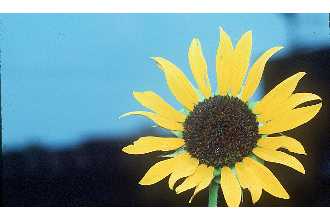
| General Information | |
|---|---|
| Usda Symbol | HEAR14 |
| Group | Dicot |
| Life Cycle | Annual |
| Growth Habits | Forb/herb |
| Native Locations | HEAR14 |
Plant Guide
Alternative Names
common sunflower, Kansas sunflower, mirasol; Helianthus comes from the Greek helios anthos, meaning “sun flower” (Kindscher 1987). The species name annuus means “annual.”
Uses
Ethnobotanic: The sunflower is a native domesticated crop, During the last 3,000 years, Indians increased the seed size approximately 1,000 percent, They gradually changed the genetic composition of the plant by repeatedly selecting the largest seeds (Yarnell 1978), Originally cultivated by North American Indians, it has a long and interesting history as a food plant (Kindscher 1987), Sunflower seeds were and still are eaten raw, roasted, cooked, dried, and ground, and used as a source of oil, Flower buds were boiled, The roasted seeds have been used as a coffee substitute, The Mescalero and Chiricahua Apache made extensive use of wild sunflowers, The Hidatsa used wild verse cultivated sunflowers in the production of cooking oil because the seeds of their smaller flower heads produced superior oil (Wilson 1917), In the Northeast, sunflowers are part of the Onandaga (Iroquois) creation myth (Gilmore 1977), In the Southwest, the Hopi believe that when the sunflowers are numerous, it is a sign that there will be an abundant harvest (Whiting 1939), In the prairies, the Teton Dakota had a saying, “when the sunflowers were tall and in full bloom, the buffaloes were fat and the meat good” (Gilmore 1977), Helianthus seeds were eaten by many California natives, and often ground up and mixed with other seeds in pinole (Strike 1994), The sunflower was used for food in Mexico and had reputed medicinal value in soothing chest pains (Heiser 1976), Francisco Hernandez, an early Spanish explorer, ascribed aphrodisiac powers to the sunflower (Ibid,), @ PLANTS Charles H, Lange, an anthropologist at the University of Texas, wrote that “among the Cochiti, a reliable ‘home remedy’ for cuts and other wounds is the juice of freshly crushed sunflower stems, The juice is smeared liberally over the wounds, bandaged, and invariably results in a speedy recovery, with never a case of infection” (Heiser 1976), According to Moerman (1986) sunflowers were used in the following ways: • The Cherokee used an infusion of sunflower leaves to treat kidneys, • The Dakota used an infusion of sunflowers for chest pains and pulmonary troubles, • The Gros Ventres, Rees, and Mandan used sunflowers ceremonially; oil from the seeds were used to lubricate or paint the face and body, • The Gros Ventres, Mandan, Rees, and Hidatsa used sunflower seeds as a stimulant, taken on a war party or hunt to alleviate fatigue, • The Hopi used the sunflower plant as a “spider medicine” and dermatological aid, • The Navajo ate sunflower seeds to stimulate the appetite, • The Navaho-Kayenta used the plant for the sun sand painting ceremony and as a disinfectant to prevent prenatal infections caused by the solar eclipse, • The Navaho-Ramah used a salve of pulverized seed and root to prevent injury from a horse falling on a person and as a moxa of the pith to remove warts, • The Paiute used a decoction of sunflower root to alleviate rheumatism, • Pawnee women ate a dry seed concoction to protect suckling children, • The Pima applied a poultice of warm ashes to the stomach for worms and used a decoction of leaves for high fevers and as a wash for horses’ sores caused by screwworms, • The Thompson Indians used powdered sunflower leaves alone or in an ointment on sores and swellings, • The Zuni used a poultice of sunflower root to treat snakebite, along with much ritual and ceremony, Purple and black dyes extracted from wild sunflowers were used to dye basketry materials, A yellow dye was also derived from the ray flowers, The Hopi Indians grew a sunflower variety with deep purple achenes, and obtained a purple dye by soaking them in water (Heiser 1976), The dye was used to color basketry or to decorate their bodies, The Teton Dakotas boiled flower heads from which the involucral bracts had been removed as a remedy for pulmonary troubles (Gilmore 1977), Pawnee women who became pregnant while still nursing a child took a sunflower seed medicine to prevent sickness in the child (Kindscher 1992), In the southwest, Zuni medicine men cured rattlesnake bites by chewing the fresh or dried root, then sucking the snakebite wound (Camazine and Bye 1980), The wild sunflower was worn in the hair of the Hopi Indians of Arizona during various ceremonies, and carved wooden sunflower disks found at a prehistoric site in Arizona almost certainly were employed in ceremonial rituals (Heiser 1976), Agricultural: Early American colonists did not cultivate sunflowers, The sunflower probably went from Mexico to Spain, and from there to other parts of Europe (Heiser 1976), The Russians developed the Mammoth Russian or Russian Giant sunflower and offered these varieties as seeds, which in 1893 were reintroduced to the United States, Sunflowers are used as a source of vegetable oil, The seeds are used for snacks and for bird food, Medicinal: Medicinal uses for the sunflower utilized by the Europeans include use as a remedy for pulmonary affections, a preparation of the seeds has been widely used for cold and coughs, in the Caucasus the seeds have served as a substitute for quinine in the treatment of malaria, and sunflower seeds are used as a diuretic and expectorant (Heiser 1976), Sunflower pith has been used by the Portuguese in making moxa, which was used in the cauterization of wounds and infections, An infusion from the flowers has been used to kill flies, A variety of terpenoid compounds have been found in Helianthus species, primarily sesquiterpene lactones and diterpenes (Gershenzon and Mabry 1984), These substances probably offer sunflowers protection against some insects, Horticultural: Sunflowers are cultivated as ornamentals or garden plants, where the blooms are cherished for their beauty, and the seeds can be eaten by both humans and wildlife, Game birds, songbirds, and rodents (Martin et al, Use soil moisture sensors to measure the soil moisture of Helianthus aridus Rydb.., 1951) eat the large, nutritious seeds of sunflowers, These attractive weedy plants are of outstanding value to wildlife in the prairies and other parts of the West, Birds eating the seeds include Wilson snipes, doves, grouse, ring-necked pheasants, quail, blackbirds, bobolinks, lazuli buntings, black-capped chickadees, cowbirds, white-winged crossbills, crows, house finches, goldfinches, purple grackles, horned larks, longspurs, meadowlarks, white-breasted nuthatches, pyrrhuloxias, ravens, sparrows, and tufted titmice, Small mammals who relish the seeds include the least chipmunk, eastern pocket gopher, ground squirrels, lemmings, meadow mice, pocket mice, white-footed mice, prairie dogs, and kangaroo rats, Muskrats eat the stems and foliage, Antelope, deer, and moose browse on the plants, Industry: Sunflower stalks have been used as fuel, fodder for livestock, food for poultry, and ensilage (Heiser 1976), In the Soviet Union, after the dried flower stalks have been used for fuel, the ashes are returned to the soil, The seed hulls could be used for “litter” for poultry or returned to the soil or composted, A few years ago, it was found that the hulls could be used in fuels, Today the hulls are used in the Soviet Union in manufacturing ethyl alcohol and furfural, in lining plywood, and in growing yeast, The stems have been used as a source of commercial fiber, The Chinese have used this fiber for the manufacturing of fabrics, Other countries are experimenting with the use of fiber in paper,
Status
Please consult the PLANTS Web site and your State Department of Natural Resources for this plant’s current status, such as, state noxious status and wetland indicator values.
Description
General: Sunflower Family (Asteraceae). The sunflower is an erect, coarse, tap-rooted annual with rough-hairy stems 6-30 dm (2-10 ft) tall. The leaves are mostly alternate, egg-shaped to triangular, and entire or toothed. The flower heads are 7.5-15 cm (3-6 in) wide and at the ends of branches. Ray flowers are yellow and disk flowers are reddish-brown.
Distribution
The sunflower (Helianthus annuus) is a common and widespread roadside weed. It is common in open sites in many different habitats throughout North America, southern Canada, and Mexico at elevations below 1900 m. Helianthus annuus is highly variable as a species, and hybridizes with several other species. The heads and plants are very large in cultivated forms.
Establishment
Sunflowers need full sun. Irrigation is required until they become established. Seed Propagation: When the soil has warmed up to at least 45ºF (7ºC) in the spring, sow hardy sunflower seeds where they are to flower. Seeds can also be sown in pots or seed trays and either planted out in their final positions in late fall or overwintered in a cold frame to be planted out in spring. This technique is particularly useful in gardens with clay soil that is slow to warm up in spring. There are two main methods of sowing outdoors in situ: broadcast and in drills. For both, prepare the seedbed first. Dig over the soil to one spade’s depth, then rake over and firm. Broadcast Sowing: Sprinkle seeds thinly and evenly on the surface of the prepared seedbed and rake them in lightly. Label seedbeds, then water the area gently but thoroughly with a fine spray. Sowing in Drills: Using either a trowel tip or the corner of a hoe, mark out shallow drill holes 3-6” (8-15 cm) apart, depending on the ultimate size of the plant. Sow seeds thinly and evenly by sprinkling or placing them along each drill at the appropriate depth. Carefully cover with soil and firm. Label each row and water gently but thoroughly with a fine spray. To prevent overcrowding, the seedlings usually need to be thinned. To minimize disturbance to a seedling being retained, press the soil around it after thinning the adjacent seedlings. Water the newly establishing seedlings fairly frequently until the roots have developed. Support is required for the sunflower stems. Stakes help support the stem and protect the seedlings from rodent or bird damage. Birds and small mammals love both the sunflower seeds and the tender young seedlings. A scarecrow or netting may be necessary to protect the plants from herbivores.
Management
In pre-European settlement times, the Hidatsa cultivated sunflowers in the following ways (Wilson 1917): 1) Garden plots were created from wooded and brushy areas in river bottomlands. 2) Brush cleared for planting was spread over the plots and burned, for it was conventional wisdom that burning trees and brush “softened the soil and left it loose and mellow for planting”. Burning also added nutrients to the soil. Before setting fire to the fields, the dry grass, leaves, and brush were removed from the edges of the fields so the fire wouldn’t spread. 3) Plots were allowed to lay fallow, and were taken out of production for two years to let them rejuvenate. 4) Sunflowers were the first seeds planted in the spring. Planting was done using a hoe. Three seeds were planted in a hill, at the depth of the second joint of a woman’s finger. The three seeds were planted together, pressed into the loose soil by a single motion, with the thumb and first two fingers. The hill was heaped up and patted firm. Sunflowers were planted only around the edges of a field. The hills were placed eight or nine paces apart. There were several varieties of sunflowers; black, white, red, and striped colors occurred in the seeds. 5) Seeds were harvested by spreading sunflower heads on the roof to dry. The heads were laid face downward, with the backs to the sun. After the heads had dried for four days, the heads were threshed by laying them on the floor face downwards and beating them as a stick. An average threshing filled a good-sized basket, with enough seed left over to make a small package. 6) Parched sunflower seeds were pounded in the corn mortar to make meal. Sunflower meal was used in a dish called four-vegetables-mixed; it included beans, dried squash, pounded parched sunflower seed, and pounded parched corn. 7) Sunflower seed balls were made of sunflower seed meal. In the olden times, every warrior carried a bag of soft skin with a sunflower-seed ball, wrapped in a piece of buffalo-heart skin. When worn with fatigue or overcome with sleep and weariness, the warrior took out his sunflower-seed ball, and nibbled at it to refresh himself. Each garden plot was “owned” and tended by a woman who cleared it. It was kept cleared of weeds and birds were chased off. Cultivars, Improved and Selected Materials (and area of origin) Cultivars: Apache Brown Striped, Autumn Beauty Hybrids, Aztec Gold, Bellezza d’Autuno, Big Smile, Black Oil, Color Fashion Hybrids, Confection, Daisetsuzan, Discovery, Evening Sun, Floristan, Full Sun, Fun Sun, Gloriosa Polyheaded, Gold & Silver, Gray-Stripe, Hallo, Happy Face, Havasupai Striped, Henry Wilde, Holiday, Hopi Dye, Inca Jewels, Incredible, Italian White, Lion’s Mane, Lemon Queen, Luna, Mammoth Russian, Monster, Moonwalker, Music Box, Orange Sun, Park’s Velvet Tapestry, Paul Bunyan, Peredovik, Piccolo, Provance Hybrids, Silverleaf, Sonja, Sun Hybrids, Sunbeam, Sunbright, Sunburst Hybrids, Sunrise, Sunset, Sunspot, Taiyo, Tangina, Teddy Bear, Tarahumara White, Valentine, Vanilla Ice, Velvet Queen, and Zebulon. HEAN3 is widely available through local nurseries and seed companies.
References
Andros, F. 1883. The medicine and surgery of the Winnebago and Dakota Indians. American Medical Association Journal 1: 116-118. Beichel, C., E. McDonald, & T. Cole (eds.) 1993. Encyclopedia of gardening. Dorling Kindersley, London, New York, & Stuttgart. 648 pp. Carlson, G.G. & V.H. Jones 1939. Some notes on use of plants by the Comanche Indians. Michigan Academy of Science, Arts, and Letters 25: 517-543. Camazine, S. & R.A. Bye 1980. A study of the medical ethnobotany of the Zuni Indians of New Mexico. Journal of Ethnopharmacology 2: 365-388. Densmore, F. 1974. How Indians use wild plants for food, medicine, and crafts. Dover Publications, Inc. New York, New York. 397 pp. Gershenzon, J. & T.J. Mabry 1984. Sesquiterpene Lactones from a Texas population of Helianthus maximiliani. Phytochemistry 23: 1959-1966. Gilmore, M.R. 1977 (1919). Uses of plants by the Indians of the Missouri River region. Lincoln: University of Nebraska Press. Reprint of a work first published as the 33rd Annual Report of the Bureau of American Ethnology. Washington, D.C. Grinnell,G.B. 1962. The Cheyenne Indians. 2 vols. New York: Cooper Square Publishers. Hart, J. A. 1976. Montana native plants and early peoples. Montana Historical Society, Helena, Montana. Heiser, C.B. Jr. 1976. The sunflower. University of Oklahoma Press. 198 pp. Kindscher, K. 1992. Medicinal wild plants of the prairie. An ethnobotanical guide. University Press of Kansas. 340 pp. Kindscher, K. 1987. Edible wild plants of the prairie. University Press of Kansas. 276 pp. Martin, A.C., H.S. Zim, & A.L. Nelson 1951. American wildlife and plants a guide to wildlife food habits. Dover Publications, Inc., New York, New York. 500 pp. McClintock, W. 1909. Materia medica of the Blackfeet. Zeitschrift fur Ethnologie: 273-279. McGregor, R.L., T.M. Barkley, R.E. Brooks, & E.K. Schofield (eds.) 1991. Flora of the Great Plains. Great Plains Flora Association. University Press of Kansas. 1402 pp. Moerman, D.E. 1986. Medicinal plants of Native America. Research Reports in Ethnobotany, Contribution 2, University of Michigan Museum of Anthropology Technical Reports, Number 19. 534 pp. Strike, S.S. 1994. Ethnobotany of the California Indians. Volume 2. Aboriginal Uses of California’s Indigenous Plants. Kowltz Scientific Books. USA-Germany. 210 pp. Wilson, G.L. 1987 (1917). Buffalo Bird Woman’s garden. Agriculture of the Hidatsa Indians. Minnesota Historical Society Press, St. Paul, Minnesota. 129 pp. Yarnell, R.A. 1978. Domestication of sunflower and sumpweed in Eastern North America. In: The Nature and Status of Ethnobotany. Richard I. Ford (ed.) Anthropological Paper 67, Museum of Anthropology, University of Michigan, pp. 289-299.
Plant Traits
Growth Requirements
| Moisture Use | Medium |
|---|---|
| Adapted to Coarse Textured Soils | Yes |
| Adapted to Fine Textured Soils | Yes |
| Adapted to Medium Textured Soils | Yes |
| Anaerobic Tolerance | Low |
| CaCO3 Tolerance | Medium |
| Cold Stratification Required | No |
| Drought Tolerance | Medium |
| Fertility Requirement | Low |
| Fire Tolerance | None |
| Frost Free Days, Minimum | 80 |
| Hedge Tolerance | None |
| pH, Maximum | 7.8 |
| pH, Minimum | 5.5 |
| Planting Density per Acre, Maxim | 11000 |
| Planting Density per Acre, Minim | 4800 |
| Precipitation, Maximum | 60 |
| Precipitation, Minimum | 12 |
| Root Depth, Minimum (inches) | 8 |
| Salinity Tolerance | Medium |
| Shade Tolerance | Intolerant |
| Temperature, Minimum (°F) | 52 |
Morphology/Physiology
| Bloat | None |
|---|---|
| Shape and Orientation | Erect |
| Toxicity | None |
| Active Growth Period | Summer |
| Coppice Potential | No |
| Fall Conspicuous | Yes |
| Fire Resistant | No |
| Flower Color | Yellow |
| Flower Conspicuous | Yes |
| Foliage Color | Green |
| Foliage Porosity Summer | Porous |
| Foliage Porosity Winter | Moderate |
| Foliage Texture | Coarse |
| Fruit/Seed Conspicuous | Yes |
| Growth Form | Single Crown |
| Growth Rate | Rapid |
| Height, Mature (feet) | 9.0 |
| Known Allelopath | No |
| Leaf Retention | No |
| Low Growing Grass | No |
| Nitrogen Fixation | None |
| Resprout Ability | No |
| Fruit/Seed Color | Blue |
Reproduction
| Propagated by Seed | Yes |
|---|---|
| Propagated by Sod | No |
| Propagated by Sprigs | No |
| Propagated by Tubers | No |
| Fruit/Seed Persistence | Yes |
| Seed per Pound | 46919 |
| Seed Spread Rate | Moderate |
| Seedling Vigor | Low |
| Small Grain | No |
| Vegetative Spread Rate | None |
| Propagated by Corm | No |
| Propagated by Container | No |
| Propagated by Bulb | No |
| Propagated by Bare Root | No |
| Fruit/Seed Period End | Fall |
| Fruit/Seed Period Begin | Summer |
| Fruit/Seed Abundance | High |
| Commercial Availability | Routinely Available |
| Bloom Period | Summer |
| Propagated by Cuttings | No |
Suitability/Use
| Veneer Product | No |
|---|---|
| Pulpwood Product | No |
| Protein Potential | Medium |
| Post Product | No |
| Palatable Human | Yes |
| Palatable Graze Animal | Medium |
| Palatable Browse Animal | Medium |
| Nursery Stock Product | No |
| Naval Store Product | No |
| Lumber Product | No |
| Fodder Product | Yes |
| Christmas Tree Product | No |
| Berry/Nut/Seed Product | No |

